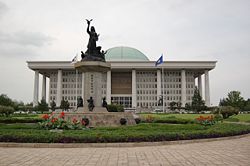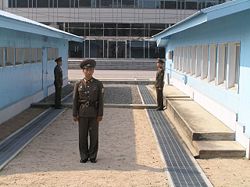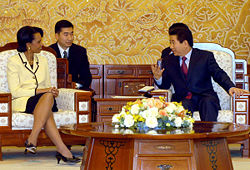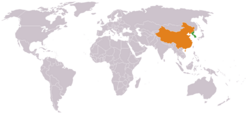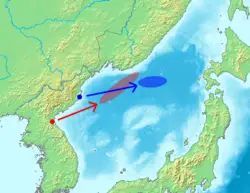Foreign relations of South Korea
| South Korea |
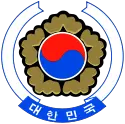 This article is part of the series: |
|
|
| Government |
|---|
|
Sixth Republic |
|
President Prime Minister Ministries |
|
National Assembly |
|
Supreme Court |
| Others |
|
Korean reunification |
South Korea's foreign relations have been shaped by its evolving relationship with North Korea, Russia, China, Japan, and the United States. The Cold War became hot for the first time on the Korean Peninsula. Russia, China, Japan, and the United States have had vested interest in the outcome of the civil war between North Korea and South Korea. A truce has been in effect since 1953 yet, technically, the two Koreas are at war. Their weapons are formidable and war has been a possibility at any time since 1953.
In the midst of that awful tension, shrugging off a humiliating experience under Japan's colonial government, rising from the rubble of the Korean War, South Korea now belongs among the world's developed nations, maintaining diplomatic relations with almost all nations in the world.
Structure of foreign affairs
Executive in foreign affairs The Constitution of the Sixth Republic established the office of foreign affairs in South Korea. The presidency sets forth major foreign policy objectives as established by the Constitution and, along with the State Council, hold decision making power, subject to the approval of the National Assembly. The Constitution requires the president and prime minister to report periodically to the legislature on foreign affairs. The president appoints envoys without confirmation; legislative consent is required for treaties, declarations of war, dispatch of troops overseas, and stationing foreign troops within the national borders (Article 60 of the Constitution). The president directs the Agency for National Security Planning, which is comparable to a combination of the United States Central Intelligence Agency and Federal Bureau of Investigation.
The National Assembly
The National Assembly maintains the Foreign Affairs Committee, which reports regularly in plenary sessions of the assembly. The assembly may also establish ad hoc committees to consider questions of special importance to the state.
Prime Minister and Minster of Foreign Affairs The prime minister, who heads the cabinet, and the minister of foreign affairs sit as the chief foreign policy advisers in the State Council. From time to time, the National Assembly may question those officials; the Assembly may pass a recommendation for the removal from office of the prime minister or a State Council member (Article 63).
National Security Council The National Security Council assists the president in the formulation and execution of foreign, military, and domestic policies related to national security prior to their deliberation by the State Council (Article 91).
Diplomatic Missions Abroad Diplomatic missions abroad conduct foreign policy. Civil service members and a career foreign service corps, selected on the basis of college education and an examination, make up the Ministry of Foreign Affairs staff. Staff undergo training in international diplomacy, specialized area training, and intensive language training conducted by the Foreign Affairs Research Institute. South Korea has diplomats assigned to more than 170 countries dealing with political and economic issues. The U.S. and Korea cooperate under the 1954 Mutual Defense Treaty. South Korea and Japan confer on a host of issues, including consultations with the United States on North Korea policy.
United Nations and International Forums In August 1991, South Korea joined the United Nations, along with North Korea, and has actively participated in United Nations agencies and international forums. South Korea belongs to the Organization for Economic Co-operation and Development (OECD) as well as the Asia-Pacific Economic Cooperation (APEC) forum. Ban Ki-moon, the former foreign minister of South Korea, sits as the incumbent Secretary-General of the United Nations.
International Events South Korea has hosted the 1988 Summer Olympics, the 2018 Winter Olympics, and the 2002 World Cup Soccer Tournament (co-hosted with Japan).
North Korea‚ÄďSouth Korea relations
Since the Korean War, relations between North and South Korea have been strained. Official, though irregular and highly secret, contact did not occur until in 1971; these meetings led to Red Cross contacts and family reunification projects but not to a peace treaty or lessening of military tensions.
Subsequent inter-Korean relations may be divided into five periods: The first stage, between 1972 and 1973; the second stage, P'yongyang's delivery of relief goods to South Korea after a typhoon caused devastating floods in 1984; the third stage, the exchange of home visits and performing artists in 1985; the fourth stage, activated by Nordpolitik under Roh. Roh's initiative built upon the 1972 three basic principles for Korean reunification: 1) Reunification by peaceful means, 2) by transcending ideological differences (nationalism), and 3) without external interference (self-determination). The fifth stage followed the 1997 election of Kim Dae-jung and his "Sunshine Policy" of engagement with North Korea.
With that policy, continued by the following administration of president Roh Moo-hyun, economic ties between the two countries increased, humanitarian aid sent to North Korea and some divided families have been briefly reunited. Military ties remain fraught with tension, however, and in 2002 a brief naval skirmish left four South Korean sailors dead, leaving the future of the Sunshine policy uncertain. North Korea cut off talks but the South remained committed to the policy of reconciliation and relations began to thaw again. The resurgence of the nuclear issue two years later would again cast relations in doubt, but South Korea has sought to play the role of intermediary rather than antagonist, and economic ties at the time seemed to be growing again.
Despite the Sunshine Policy and efforts at reconciliation, the progress was complicated by North Korean missile tests in 1993, 1998, 2006 and 2009. As of early 2009, relationships between North Korea and South Korea were very tense; North Korea had been reported to have deployed missiles, Ended its former agreements with South Korea and threatened South Korea and the United States not to interfere with a satellite launch it had planned. As of 2009 North Korea and South Korea are still opposed and share a heavily fortified border.
On May 27, 2009 North Korea media declared that the armistice is no longer valid due to the South Korean government's pledge to "definitely join" the Proliferation Security Initiative. To further complicate and intensify strains between the two nations is the sinking of the South Korean warship Cheonan in March 2010, killing 46 seamen. A team of researchers around the world claimed it was caused by a North Korean torpedo, which the North denied. South Korea agreed with the findings from the research group and president Lee Myung-bak declared in May 2010 that Seoul would cut all trade with North Korea as part of measures primarily aimed at striking back at North Korea diplomatically and financially. As a result of this, North Korea severed all ties and completely abrogated the previous pact of non aggression.
In November 2010, the Unification Ministry officially declared the Sunshine Policy a failure, thus bringing the policy to an end. On November 23, 2010, North Korean artillery shelled Yeonpyeong with dozens of rounds at Yeonpyeong-ri and the surrounding area.
In May 2017, Moon Jae-in was elected President of South Korea with a promise to return to the Sunshine Policy. Beginning with North Korea's participation in the 2018 Winter Olympics, the relationship has seen a major diplomatic breakthrough and become significantly warmer. In April 2018, the two countries signed the Panmunjom Declaration for Peace, Prosperity and Unification of the Korean Peninsula. In 2018, a majority of South Koreans approved the new relationship. The summits between North and South Korea have also facilitated positive relationships between North Korea and the United States. However, tensions between the two countries remain.
United States
South Korea's relations with the United States intensified in 1948, when the U.S. helped establish South Korea and fought on its UN-sponsored side in the Korean War (1950‚Äď1953). During the following four decades, South Korea experienced tremendous economic, political, and military growth. Since the late 1980s, South Korea has become a partner rather than a dependent nation, opening new opportunities and new strains in the Seoul-Washington relationship.
In 1989, the United States stood as South Korea's largest and most important trading partner, while South Korea ranked as the seventh-largest market for United States goods and the second largest market for its agricultural products. United States congress, under pressure to find a cure for an imbalance in trade with South Korea and other nations, sought to improve the balance. A free trade agreement (FTA) between South Korea and the United States became controversial, leading to fears among the Korean people of a loss of the rapid gain in quality of life and increased per-capita income. South Koreans protested against FTA talks.
Security renegotiations also tried the new partnership. Most Koreans believed that United States forces should remain in South Korea as long as Seoul needed them, 94 percent of South Koreans supported the presence of United States forces. Stability in the peninsula required a strong Seoul-Washington military cooperation to deter North Korean aggression.
A small faction voiced the demand that United States troops should gradually leave South Korea. In Washington, an increasing number of United States policymakers supported that view. Consultations on restructuring the Washington-Seoul security relationship took place in February 1990, marked a shift in U.S. policy to a supporting, rather than leading, role in South Korea's defense and increasing support of defense expense.
The United States' role in the May 1980 Gwangju uprising was the single most pressing South Korean political issue of the 1980s. Even after a decade, Gwangju citizens and other Koreans still blamed the United States for its perceived involvement in the bloody uprising.
Washington's policymakers applauded Nordpolitik as a necessary adjustment of the relationship between Seoul and Moscow. However, the South Korean press contributed to a distorted zero-sum notion of the situation‚ÄĒif ties with the Soviet Union improve, then it must cause strains in the relationship with the United States. In his February 1989 speech to the South Korean National Assembly, President George Bush defined continuity and change as the guideposts in Seoul-Washington relations.
The relations between the United States and South Korea greatly strengthened under the Lee Myung-bak administration. At the 2009 G-20 London summit, U.S. President Barack Obama called South Korea "one of America's closest allies and greatest friends."
In a June 2010 open letter from President of South Korea Lee Myung-bak published in the Los Angeles Times, he expressed gratitude for the 37,000 Americans who were killed in the Korean War defending South Korea, saying that they fought for the freedom of South Koreans they did not even know. He stated that thanks to their sacrifices, the peace and democracy of the South Korean state was protected.
China (PRC)
Active South Korean-Chinese people-to-people contacts have long been encouraged. Academics, journalists, and particularly families divided between South Korea and the People's Republic of China (PRC) were able to exchange visits freely in the late 1980s.
Trade between the two countries has continued to increase. Furthermore, China has attempted to mediate between North Korea and the United States and between North Korea and Japan. China has also initiated and promoted tripartite talks between North and South Korea and the United States.
South Korea had long been an ally of Taiwan. Diplomatic ties between Seoul and Taipei were nevertheless severed in 1992. Formal diplomatic relations were established between Seoul and Beijing on August 24, 1992.
Taiwan (ROC)
On August 23 1992, the government of the Republic of China (by then only in control of the island of Taiwan and a few outlying areas) severed diplomatic relations with South Korea in advance of its announcement of formal recognition of the People's Republic of China based in Beijing. The Yonhap News said in 2002 that since then, relations between the two governments have been "in a rut."
Japan
South Korea's relations with Japan still deal with the aftermath of Japan's occupation of Korea, including the Sea of Japan naming dispute, visits by successive Japanese Prime Ministers to the Yasukuni Shrine, and the disputed ownership of Liancourt Rocks (known as Dokdo in South Korea, Takeshima in Japan). Since normalizing relations in 1965, Seoul and Tokyo have held annual foreign ministerial conferences to discuss trade, the status of the Korean minority population in Japan, the content of textbooks dealing with the relationship, and Tokyo's relationship with North Korea.
Since 1965, Japan's government officials have been issuing statements of regret and apology for actions during the colonization of Korea. Those remarks began with ambiguous apologies that seemed to lack sincerity in 1965, to clear unambiguous apologies in 2003. Prime Minister Koizumi Junichiro's statement made in Pyongyang, September 17, 2002, constitutes the clearest statement of apology:
The Japanese side regards, in a spirit of humility, the facts of history that Japan caused tremendous damage and suffering to the people of Korea through its colonial rule in the past, and expressed deep remorse and heartfelt apology.
Roh's Nordpolitik helped ease tensions with Tokyo over their approach to P'yongyang. In 1996 FIFA announced that the South Korea-Japan would jointly host the 2002 FIFA World Cup. The next few years would see leaders of both countries meet to warm relations in preparations for the games. The year 2005 was designated as the "Japan-South Korea Friendship Year."
However, the Liancourt Rocks controversy erupted again when Japan's Shimane prefecture declared "Takeshima Day," inciting mass demonstrations in South Korea.
Russia
Seoul-Moscow relations entered a new era in the 1980s. Roh's Nordpolitik and Mikhail Gorbachev's "New Thinking" had much in common as they attempted to reverse their nations' courses. Gorbachev had signaled Soviet interest in improving relations with all countries in the Asia-Pacific region, including South Korea, as set forth his July 1986 Vladivostok and August 1988 Krasnoyarsk speeches.
Improved Seoul-Moscow relations occurred in three arenas: Sports, trade, and political relations. The Seoul Olympics provided a major catalyst. The Soviets, eager to participate in the games, received honored treatment at the Olympics from South Korea.
Economically, Seoul and Moscow have been natural partners. South Korea sought trade with the Soviet Union even before Gorbachev came to power. Gorbachev desired foreign capital and high technology, as well as Seoul's help in alleviating the Soviet economic crisis through direct investment, joint ventures, and trade. South Korea offers a source of badly needed consumer goods and managerial skills.
Russia has the natural resources‚ÄĒoil, metals, timber, and fish‚ÄĒthat South Korea desperately needs. The United States encouraged South Korea's expanding trade with Eastern Europe and the Soviet Union initially, although Washington later expressed concerned over high-technology transfers to Russia. Seoul and Moscow began trading directly, without Eastern European intermediaries, from facilities near Vladivostok and Pusan. Several major South Korean businesses including Daewoo, Sunkyong, and Lucky-Goldstar traded directly with the Soviet Union in 1990. The Korean Trade Promotion Corporation (KOTRA) and the Soviet Chamber of Commerce and Industry exchanged a trade memorandum in 1988, pledging mutual assistance in establishing trade offices in 1989.
South Korea's wealth and technology Roh Tae-wo and Kim Young Sam visited Moscow in the late 1980s. Kim Young Sam participated in talks with the newly elected chairman of the Supreme Soviet, academician Yevgeni Primakov. In a joint statement, the Reunification Democratic Party (RDP) and IMEMO pledged to promote closer trade and cultural ties between the two nations. The Kremlin announced that it would allow some 30,000 Koreans stranded on Sakhalin since the end of World War II to return permanently to South Korea‚ÄĒclearly a reflection of the continuing improvement in Seoul-Moscow relations. Moscow arranged a Seoul-P'yongyang meeting. Kim met with Ho Tam, chairman of the Committee for Peaceful Reunification of the Fatherland (CPRF) in Moscow. In June 1990, Roh held his first summit with President Gorbachev in San Francisco.
These relations continued by the Russian Federation on December 27, 1991. Russian president Vladimir Putin visited Seoul in February 2001 while South Korean president Roh Moo-hyun visited Moscow Russia in September 2004.
Russian Federal Space Agency and the Korean Astronaut Program cooperated together to send South Korea's first astronaut into space. Yi So-Yeon became the first South Korean national as well as the third woman to be the first national in space on April 8, 2008.
United Nations and international organizations
South Korea has been active in the United Nations, becoming a member in 1991 at the same time as North Korea. On January 1, 2007, South Korean Foreign Minister Ban Ki-moon assumed the post of UN Secretary-General, serving in that post until December 31, 2016.
In addition to holding membership in the United Nations, South Korea is a member of the WTO, OECD/DAC, ASEAN Plus Three, East Asia Summit (EAS), and G-20. It is also a founding member of Asia-Pacific Economic Cooperation (APEC) and the East Asia Summit.
ReferencesISBN links support NWE through referral fees
- Bandow, Doug. 1996. Tripwire: Korea and U.S. Foreign Policy in a Changed World. Washington, D.C.: CATO Institute. ISBN 9781882577293
- Buss, Claude Albert. 1982. The United States and the Republic of Korea: Background for Policy. Stanford, Calif: Hoover Institution Press, Stanford University. ISBN 9780817975425
- ChŇŹng, Chae-ho. 2007. Between Ally and Partner: Korea-China relations and the United States. New York: Columbia University Press. ISBN 9780231139069
- Dallin, Alexander. 1985. Black Box: KAL 007 and the Superpowers. Berkeley: University of California Press. ISBN 9780520055155
- Dudley, William. 2003. North and South Korea: Opposing Viewpoints. San Diego: Greenhaven Press. ISBN 9780737712360
- Harrison, Selig S. 2002. Korean Endgame: A Strategy for Reunification and U.S. Disengagement. Princeton, N.J.: Princeton University Press. ISBN 9780691096049
- Lee, Chae-Jin. 2006. A Troubled Peace: U.S. Policy and the two Koreas. Baltimore: Johns Hopkins University Press. ISBN 9780801883309
| ||||||||
Credits
New World Encyclopedia writers and editors rewrote and completed the Wikipedia article in accordance with New World Encyclopedia standards. This article abides by terms of the Creative Commons CC-by-sa 3.0 License (CC-by-sa), which may be used and disseminated with proper attribution. Credit is due under the terms of this license that can reference both the New World Encyclopedia contributors and the selfless volunteer contributors of the Wikimedia Foundation. To cite this article click here for a list of acceptable citing formats.The history of earlier contributions by wikipedians is accessible to researchers here:
The history of this article since it was imported to New World Encyclopedia:
Note: Some restrictions may apply to use of individual images which are separately licensed.
